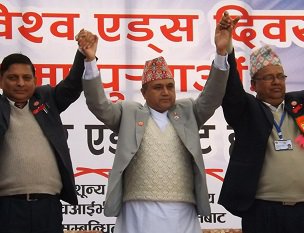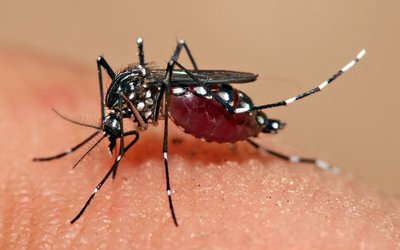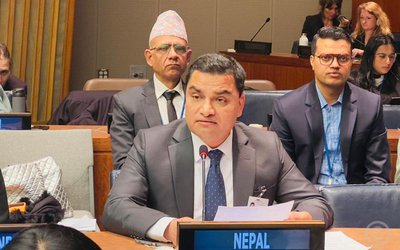
Although Nepal’s HIV/AIDS prevention program is suffering from the shortage of funds, Minister for Health and Population Khag Raj Adhikary seems to show little concern. He addressed a recent gathering celebrating the World Aids Day without making any real commitment to how to meet the shortage. At the time of writing this story, HIV/AIDS programs are reported as suffering in different parts of the country.
“The government is committed to meet the global target set by UNAIDS. We will develop our programs and plans accordingly,” said Minister Adhikari, who also participated in a random HIV test at the program. "I assure all of you that there will be no crunch of budget.”
It is easier said than done.
"The Ministry of Health and Population has already cut down the programs directed to prevent the transmission of HIV. Who will bear the cost for the testing and other medicines?" asked an activist.
Hundreds of events have been organized in cities like Pokhara , Dharan and Kathmandu focusing on prevention and treatment of HIV/AIDS. If the government is unable to generate alternative funds, its programs are sure to suffer.
Since 1988, Nepal has been observing the World Aids Day annually on 1 December, showing its dedication to raising the awareness to the Aids pandemic caused by the spread of the HIV infection.
People around the world celebrate the World AIDS Day to show their support for those living with the AIDS virus, as well as those who have died from the disease.
At the time of World AIDS Day celebrations, UNAIDS launched a new report. Fast-Track: ending the AIDS epidemic by 2030 outlines that by quickening the pace over the next five years the AIDS epidemic can be ended as a global health threat by 2030. The report also states that by doing so, 28 million new HIV infections and 21 million AIDS-related deaths will be averted.
Despite over two decades of intervention programs after the first case of HIV was detected, not many people in Nepal are aware of their HIV status. There is still stigma attached with it. The situation is similar in the other parts of the world as well.
People are still reluctant to voluntarily show up at HIV testing centres. This has been a major challenge in the country’s HIV program which has just been able to figure out 22,994 people infected with HIV among the estimated 48,600 people living with the virus in the country.
After the introduction of effective programs over the year, the number of people estimated to be living with HIV has been decreasing gradually. However, the number of reported cases is rising. Experts argue that a large chunk of people, oblivious of their HIV status, poses a great threat to the country.
The awareness among Nepalis is getting higher on HIV and AIDS. According to Nepal Demographic and Health Survey, 86 percent women and 97 percent men in the age group 15-49 years had knowledge about AIDS.
“Despite progress, there still prevails social stigma and people hesitate to voluntarily test for HIV,” said Dr Naresh Pratap KC, director of the National Centre for Aids and STD Control (NCASC). “We focus our programs more on vulnerable groups that include injection drug users, female sex workers and migrant workers,” said Dr KC.
With increase in the number of test sites, doctors often send people to test for HIV in case they find the patient to be from the risk group, including the migrants, sex workers and drug users. There are 239 service sites in the country, including 97 government sites, where HIV test is conducted and counseling provided.
At a time when Nepal has still a large number of population living without taking the HIV test, there is the need to launch a nationwide program to allow voluntary testing for HIV from authorised sites to know their status.
According to NCASC, in 2012, 120,450 people were tested for HIV and 2,433 diagnosed as HIV positive. As of July this year, 85,557 people have been tested for HIV, among whom, 1,443 are diagnosed with HIV.
UNAID’s Strategy
As AIDS related incidents are occurring, UNAIDS reports that reaching Fast-Track Targets will avert nearly 28 million new HIV infections and end the AIDS epidemic as a global health threat by 2030.
If the world does not rapidly scale up in the next five years, the epidemic is likely to spring back with a higher rate of new HIV infections than today, UNAIDS report launched ahead of the World AIDS Day said.
According to UN AIDS, an estimated 34 million people are living with HIV, the virus that causes AIDS, and more than 35 million have died from the disease. This year's theme is "Focus, Partner, Achieve: An AIDS-free Generation."
More Investment
Ahead of World AIDS Day, the United Nations Children's Fund (UNICEF) urged more investment and access to treatment for children. The group said that 1.1 million infections among children under 15 have been averted, but that more needs to be done.
UNICEF said that while all other age groups have experienced a decline of nearly 40% in AIDS-related deaths between 2005 and 2013, those aged 10-19 are the only group in which AIDS-related deaths are not decreasing.
"We must close the gap, and invest more in reaching every mother, every newborn, every child and every adolescent with HIV prevention and treatment programs that can save and improve their lives," UNICEF Executive Director Anthony Lake said.
After the pullout by the Global Fund, Nepal’s AIDS prevention program has already suffered badly. As the government has no resources to fill the vacuum, there will be more budgetary gaps in the coming days in the prevention of AIDS.
AIDS is one of the most important global public health issues in recorded history. Caused by infection with HIV, a person may experience a brief period with flu-like symptoms, before a long period with no symptoms. It renders the patient susceptible to infections like tuberculosis and certain cancers.
HIV is primarily transmitted via unprotected sexual intercourse, contaminated blood transfusions, hypodermic needles, and from mother to child, via pregnancy, delivery or breastfeeding. There are around two million deaths from Aids each year, of which about 270,000 are children.
HIV is treated with antiretrovirals, which work by stopping the virus replicating in the body, allowing the immune system to repair itself and preventing further damage. Patients tend to take three or more types of antiretrovirals – known as combination or antiretroviral therapy. Antiretroviral therapy prevents the onward transmission of HIV.
Fast Track Approach
The Joint United Nations Program on HIV/AIDS (UNAIDS) has announced that taking a Fast-Track approach over the next five years will allow the world to end the AIDS epidemic by 2030.
“We have bent the trajectory of the epidemic,” said Michel Sidibé, Executive Director of UNAIDS. “Now we have five years to break it for good or risk the epidemic rebounding out of control.”
The new set of targets that would need to be reached by 2020 include achieving 90-90-90: 90% of people living with HIV knowing their HIV status; 90% of people who know their HIV-positive status on treatment; and 90% of people on treatment with suppressed viral loads.
UNAIDS estimates that by June 2014, some 13.6 million people had access to antiretroviral therapy, a huge step towards ensuring that 15 million people have access by 2015, but still a long way off the 90-90-90 targets. Particular efforts are needed to close the treatment gap for children.
Other targets include reducing the annual number of new HIV infections by more than 75%, to 500 000 in 2020, and achieving zero discrimination. The targets are firmly based on an approach to leaving no one behind that is grounded in human rights and, if achieved, would significantly improve global health outcomes.
Fast-Track: ending the AIDS epidemic by 2030 also highlights just how critical investment is to achieving these targets. Low-income countries will require a peak of US$ 9.7 billion in funding in 2020 and lower-middle-income countries US$ 8.7 billion.
International funding support will be needed to supplement domestic investments, particularly in low-income countries, which are currently only funding around 10% of their responses to HIV through domestic sources. Upper-middle-income countries will require US$ 17.2 billion in 2020. In 2013, 80% of upper-middle-income countries were financing their responses to HIV through domestic sources.
If sufficient investments are achieved, global resource needs will start to reduce from 2020. By 2030, the annual resources required in all low- and middle-income countries will decline to US$ 32.8 billion, down 8% from the US$ 35.6 billion needed in 2020. These resources will provide antiretroviral treatment to twice as many people in 2020 than in 2015.
Focus on Cities
The UNAIDS Fast-Track approach emphasizes the need to focus on the counties, cities and communities most affected by HIV and recommends that resources be concentrated on the areas with the greatest impact.
The approach outlines that particular efforts are needed in the 30 countries that together account for 89% of new HIV infections worldwide. Fast-Track national responses in these 30 priority countries will require extensive mobilization of human, institutional and strategic international partners as well as significant commitments from both national and international sources. The importance of reaching people most affected by HIV is also outlined as key to ending the AIDS epidemic and concerns are raised about access to HIV services for people most in need
- MELAMCHI WATER SUPPLY: No Interruption During Monsoon
- Jun 25, 2025
- KOREAN RETURNEES: Successful Integration
- Jun 25, 2025
- UPPER TRISHULI-1: Engaging With Local
- Jun 25, 2025
- IME GROUP: Twenty Five Years Of Journey
- Jun 24, 2025
- NEPAL’S AIR POLLUTION: A Growing Health Concern
- Jun 24, 2025














